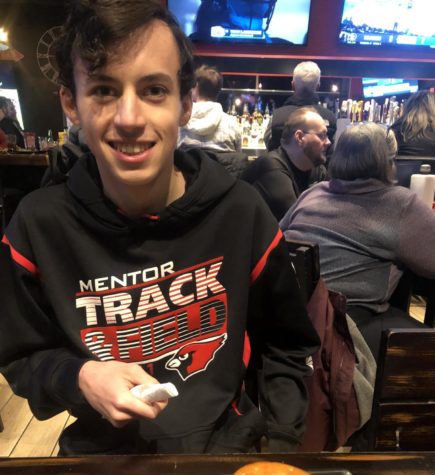Introduction

When grunge began as an underground melding of hardcore punk and heavy metal, no one knew the heights the movement would eventually achieve. Born out of Washington, specifically within Seattle, during the mid to late 1980s, grunge music came about as a movement that reflected and expressed internal angst and aggression. The movement began as a localized influence confined to the Seattle music scene, which bred a strong connection between the bands that played in the area and their audiences. This was especially true for the youth, many of whom saw grunge music as a way to emotionally connect with others through their shared frustrations in life. They shared in the enjoyment of loud, abrasive, and powerful music that they felt reflected their own emotions and the struggles they endured in their lives. Unlike metal, which often focused on fantasy and folklore within its lyrics at the time, grunge found solace within and took issue with the harsh realities of life, using lyrics that often reflected personal emotion and relatable human struggles. Grunge musicians could express themselves through their songwriting, which often centered around boredom, apathy, and societal unrest, and through their own musical sound. Both the more “down-to-earth” nature of the music, which combined with the closeness the bands in the area held to their audiences, made the grunge movement feel especially native to Seattle, eventually becoming a part of its identity.
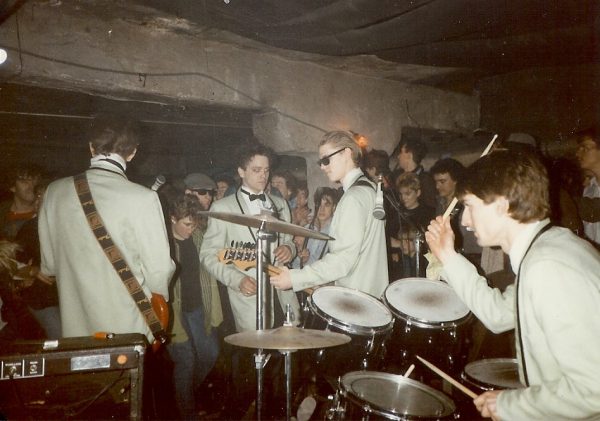
(Rachel Elizabeth Tillman – Public Domain)
At the time, grunge was decidedly non-mainstream, and took pleasure in finding ways to rebel against what was considered the norm. Those partaking in the movement often “dressed down” with ragged, informal clothing, and thrifting became an important aspect of grunge culture, as did the iconic ’90s flannel. So much of grunge was centered around rebelling against the mainstream and remaining uncommercial that the movement’s eventual catapult into popularity would surprise, if not frustrate many. All of this would begin with one band, and one specific album in particular. But never mind that for now. Within grunge music, some have pointed out a Big Four: Nirvana, Alice in Chains, Pearl Jam, and Soundgarden. Though this group is in no way official, and there were clearly many other acts of the time that can be considered influential in their own right, these four bands are noted as some of, if not the most influential within the genre, and so it may be interesting to go through their history, the impact they had, and how the journeys of each of these bands would continue through the ’90s.
Nirvana

Founded in Aberdeen, Washington, and signed to the ever present Sub Pop music label, Nirvana began as officially composed of Kurt Cobain on vocals and guitar, Kurt Novoselic on bass, and Chad Channing on drums, though they constantly rotated drummers before this point. In 1988, the band released their first album, Bleach, a short but raw and noisy grunge album that, while nothing extraordinary at the time, laid the foundation for many of the band’s later strengths, such as Cobain’s ferocious yet emotive singing and songwriting and the hidden knack for melody that the band would later expand on. Songs such as “Negative Creep” and “School” pick up the album’s pace, but most songs maintain the slower style often associated with grunge, with ballads such as “About A Girl” and “Love Buzz.” Cobain’s vocals and the album’s abrasive guitars also do a great job of showing the appeal of underground grunge at the time, as the typically grunge-like emotions of apathy and frustration in response to real-world struggle are on full display with this album’s songwriting and performances, and so is the punk attitude adopted by the movement as a whole. Overall, Bleach builds a solid foundation for the band while also demonstrating various earmarks and communicating the appeal of underground grunge in the first place.
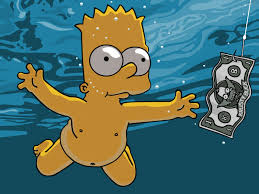
Some time after the release of Bleach, Channing would leave the band due to creative differences, and he would be replaced by Dave Grohl who would perform on the band’s sophomore album Nevermind. Released in 1991, Nevermind itself would be the album that would skyrocket grunge as a whole into the mainstream, with “Smells Like Teen Spirit,” the band’s biggest hit and one of, if not the defining song of grunge music during the 1990s. Musically, Nevermind shows a shift into more melodic territory in contrast to the abrasive Bleach, which perhaps played a role in its commercial success. Cobain’s songwriting had also become more detailed and the band’s playing had been more reined in, allowing them to better work as a unit. As of now, Nevermind has a status as one of the most influential and iconic albums of all time, and boasting some of the most well-known hits in grunge such as “Smells Like Teen Spirit,” “Come As You Are,” “Lithium,” and “Something In the Way,” it is not difficult to see why. The album would eventually reach #1 in early 1992, cementing its place in rock history, though its impact came not only from its hits. Nevermind was crucial to bringing a genre that had once been underground and accessible mostly to fans in Seattle to a much more widely exposed and commercialized sub-genre, bringing a new zeitgeist to say the least. Grunge’s relatable songwriting and the youthful angst that many feel in their own lives likely also played a part in the sub-genre’s growth and exposure, and with the release of this singular album, grunge became a cultural phenomenon. This would later allow for other grunge bands to gain their own spotlight as well.
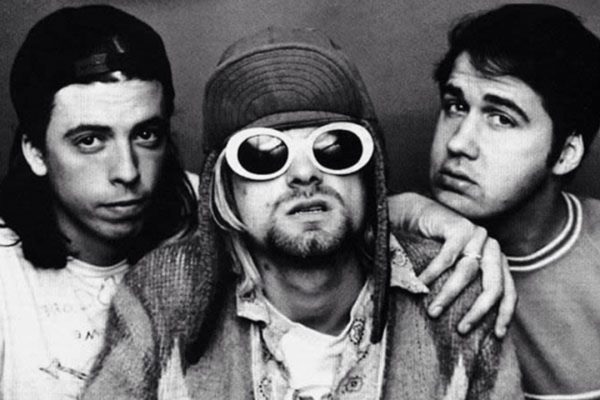
(Wes Candela – Public Domain)
Despite the enormous commercial success that grunge now brought its artists, not all were pleased with this newfound fame. Grunge had been a genre that pleased itself with going against the norm, and so grunge itself becoming the new norm rubbed many artists the wrong way. Many artists and bands, including Alice in Chains and Soundgarden, also disliked being boxed into the idea of “grunge,” considering themselves to be more inspired by metal or a blend of sub-genres. Cobain in particular detested always being in the view of the public eye, and the pressures of his newfound fame along with his drug use likely began to weigh on his mental health. Along with the band’s firm stances against homophobia and sexism, as well as his relationship with Courtney Love, lead singer of the band Hole, the Nirvana frontman would bring his own type of controversy with his rise of fame as well. Towards the end of 1993, the band would record their own set for MTV Unplugged, a series which aired on MTV and showed bands performing their own songs in a more close, intimate setting, often with acoustic instrumentation. Many of the band’s performances from this set would become some of their most powerful and well-known, including their rendition of David Bowie’s “The Man Who Sold The World” and their performance of “All Apologies.” “All Apologies” is the closing track on the band’s third album, which would release in 1994, titled In Utero. For the most part, In Utero is a return to the raw and oftentimes harsh sound of Bleach, though with more professional production and some other noticeable differences. The band’s developed knack for melodies is still present, even on the noisier tracks, and the band’s performances are more chaotic across the project. Cobain’s singing is louder and oftentimes ranges from dejected to unhinged, while the distorted guitar playing and booming drums make the project feel much more overwhelming as a whole, even if slower songs such as “Dumb” and “Pennyroyal Tea” help to give the project more breathing room. However, the lyrics and songwriting found within the album showed clear signs of distress from the band, particularly Cobain, as the fury, anguish, and exhaustion conveyed through his vocal delivery and lyrics, were too clear to be ignored. After this album, a series of circumstances would occur that would indicate the end for the band.
After his heroin usage and addiction continued to worsen, Cobain would be admitted into a treatment center in Los Angeles later in 1994. However, the frontman would somehow escape and return back to his home in Seattle, where it was later found that he had passed away from a self-inflicted gun wound. Naturally, Nirvana ended with Cobain’s death, and in fact some still credit the end of Cobain to signal the end of grunge. It was not long after this point where grunge began to decline in popularity, with pop music, other forms of alternative rock, and nu metal taking its place. However, the mark that Nirvana left on grunge, and on pop culture as a whole, cannot be understated. They had introduced the wider public to a new sub-genre of music and the musical landmark of much of the early ’90s, one which though it may not have felt comfortable being in the limelight, still left a great impression on history all the same. Music history had changed forever with the work of Nirvana.

Pearl Jam
Pearl Jam originally began life as Seattle glam rock outfit Mother Love Bone, a band whose career was cut short after the death of its lead singer Andrew Wood from an overdose. Guitarist Stone Gossard and bassist Jeff Ament began to work on starting a new band, collaborating with guitarist Mike McCready, and after a demo tape made its way over to at-the-time unknown singer Eddie Vedder, the band flew him out to Seattle and eventually hired him, impressed by his recordings. Once drummer Dave Krusen was added, the band you all know and love, Mookie Blaylock, was formed. Then the band changed its name to Pearl Jam, which after signing to Epic Records, released their debut album Ten in 1991. Straight from the beginning, Pearl Jam was noted for incorporating more of a classic rock influence into their grunge stylings, which set them apart from similar bands. Their ascendant choruses and Vedder’s deep, bellowing singing voice brought with them their classic rock influence, but many symbols and earmarks of the grunge movement still made its way into their music. From the apathy and exhaustion often conveyed in the band’s lyrics to their slower and more drawn out song structures, the band still demonstrated themselves as part of the grunge movement. Ten in particular showcases many of the band’s strength at an earlier age, with well-made and stadium-ready rock anthems filling up much of the album’s runtime. Though less fierce on the surface than many other bands, they still used their passionate performances and comparatively accessible nature to inspire and rouse emotion from listeners. Also, unlike many of their contemporaries, Pearl Jam made their commercial breakthrough with their debut, as many of their most popular songs to this day, such as “Even Flow,” “Alive,” “Black,” and “Jeremy,” land on Ten. In fact, similarly to Nevermind, the first half of the album is nearly a play-through of many of their hits, which speaks to the impact Ten had within the band’s career and within grunge music. The album would also reach #2 on the Billboard 200 in 1992, and in fact, during the early 1990s, its sales grew to surpass even those of Nevermind.
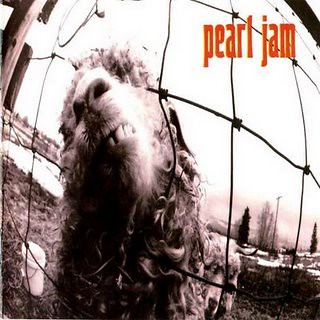
The band’s newfound popularity brought complicated responses from the band, as they, especially Vedder, found it difficult to deal with the public spotlight. The band often felt overwhelmed, and they had to work to even continue through the music landscape and withstand the popularity that grunge brought them. They took many actions to somewhat tone down their fame, including turning down certain TV specials, promotional stunts, and merchandise deals, and the band typically avoided different opportunities to expand their popularity. In fact, they even refused to produce music videos for any songs on their sophomore album, Vs., which would release in 1993. Unlike Ten, with its grand and dramatic song structures and clean production, Vs. presents itself as more rough and unkempt than its predecessor, with a generally more aggravated and angered sound. Compared to Ten, Vs. brings more harsh guitars and more chaotic drumming, which may be an indicator of the band lashing out against their current status of fame and generally conveying a certain frustration with their place in rock. Even still, slower ballads such as “Daughter” and “Indifference” sit among the band’s change in tone, which shows that they were still willing to hit more low key, resonant peaks when needed. Their classic rock influence, which was prominent within Ten, was also present, and even at their most abrasive, the band still remained more clean than their contemporaries at the time. Nonetheless, despite the relative lack of promotion for the album, and the slight change in tone, Vs. was a success for the band, as the album sat at the top of the Billboard 200 for five weeks and “Daughter” stayed at number one on the mainstream rock charts for eight weeks, becoming one of the band’s most well known songs.
The band’s third album, Vitalogy, released in 1994 not long before the loss of Cobain, sees the band turn away slightly from the grunge stylings of the first two projects and further towards general alternative and classic rock, and in return, the album has a much more varied tracklist. This is especially in contrast to Ten and Vs, where most of the songs appeared similar in style and in tone. Harder, quicker, more impassioned cuts such as “Spin the Black Circle” and “Corduroy” are mixed with slower, more tender ballads such as “Nothingman” and “Immortality,” along with the unique, if odd, sonic experiments that are “Bugs” and “Stupidmop.” The album feels much more planned out and defined in structure than Vs., and also often appears more worn and reflective in tone. Compared with its predecessors, Vitalogy was Pearl Jam’s most diverse album so far, while for the most part maintaining a consistent level of quality, and so displays the band’s versatility in a new manner.
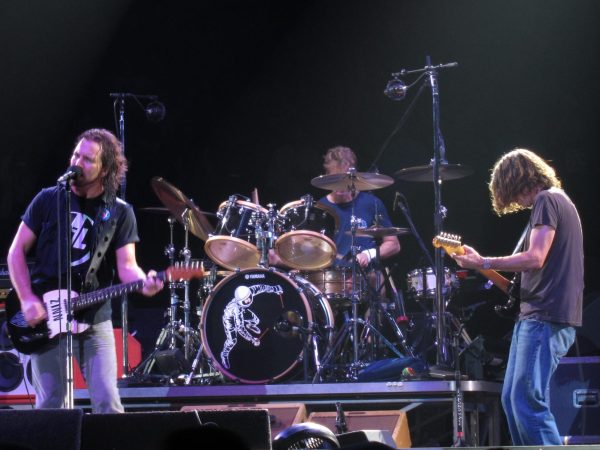
However, despite the success the band was continuing to achieve, there were internal and external struggles the band was facing. Their drummer, Dave Abbruzzese, was fired and replaced with Red Hot Chili Peppers drummer Jack Irons, and the band was having issues with ticket pricing, specifically with Ticketmaster. The band had initially took issues with booking fees, as the band wanted to charge a lower price than Ticketmaster, which caused the band to halt the tour and put them in a legal battle with the service which used up money and resources. This even led to a Justice Department investigation into Ticketmaster’s “monopolistic behavior,” though the band would lose their legal battle. Their subsequent tour would suffer as a result, as the band played in fields outside of Ticketmaster’s very vast jurisdiction, and many cancellations and logistical problems occurred. Even with the time and money taken up by battling with Ticketmaster, Pearl Jam would actually continue to put out music on a consistent basis up until the present day, and even year. Even so, the majority of the band’s most well-known material comes from their initial three albums, and it is with this run from Ten to Vitalogy, or 1992 through 1994, that they left their strongest mark on grunge, and alternative rock, history. The band had carved out a niche for themselves within the grunge landscape, bringing a new set of influences and working and performing on their own terms, leaving a very commendable imprint on the trail of grunge history that they continue to work from.
Alice In Chains
Alice In Chains was a grunge and metal band that formed in Seattle in 1987, and initially consisted of drummer Sean Kinney, bassist Mike Starr, lead guitarist and backing vocalist Jerry Cantrell, and lead singer Layne Staley. Staley’s first shot as a band vocalist would be with glam metal group Sleze, and Staley would meet Cantrell in Seattle during 1987. After Sleze, which had changed its name to Alice N’ Chains, broke up, the two would work to find other band members and start their own group, which would become what we now know as Alice In Chains.
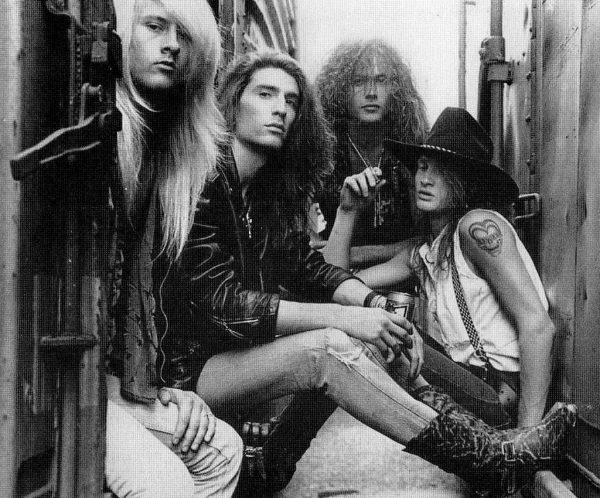
The band’s debut album, Facelift, would be released in 1990, before Nevermind had shot grunge into the mainstream. Notably, the band took more cues from heavy metal and glam metal than their contemporaries, which combined with the influence from what is now known as grunge, would arguably be part of what made Facelift stick out in the grunge landscape and within the 1990s mainstream. Though the band’s glam metal influence would fade somewhat as they continued, their overall heavy metal influence would not, and they would maintain a noticeably more metal-inspired sound than other popular grunge acts of the time. Regarding Facelift in particular, the album maintains a very slow pace throughout, particularly during its second half, with chugging guitar chords and drawn-out melodies adding to the album’s dark and dejected atmosphere. Much of Facelift maintains a very similar, cohesive sound, which could work both in its favor and against it, as though it keeps a recognizable sound, certain songs can blend together. Nonetheless, Facelift is notable for being one of the earliest grunge albums to make a presence on the radio and on the charts, even before Nevermind. The album sold well commercially, and songs such as “Man in the Box,” “We Die Young,” and “Bleed the Freak” would become well-known within the band’s catalog. Even with their more glam metal influenced style, they retain the pained and bleak lyrical content the band would continue to expand on.

During the band’s supporting tour for the album, the band would begin their drug experimentation, which would weigh on Alice in Chains, and some of its members, for the rest of their lives. Alice in Chains began to record their follow-up album in many different studios (one being in Seattle), but the recording sessions for the album in LA would be interrupted by a rather chaotic event. As the band was recording, the Rodney King riots (days of rioting in LA in response to the acquittal of four LA policeman in the beating of African-American motorist Rodney King) were spreading through LA. According to Cantrell, the band was forced to move to Venice and hang out in the desert until the riots cooled off. The band’s sophomore album, Dirt, would release in 1992, and despite the band’s progressive drug use and interruptions from the riots, the album would become their commercial breakthrough. Dirt contains songs such as “Them Bones,” “Rooster,” “Down in a Hole” and “Would?,” which would become classic songs both in grunge and within the band’s catalog, and the album would peak at number 6 on the Billboard 200, further cementing itself as part of grunge and rock history. As an album, Dirt is much more varied both in pace and in song structure and writing than its predecessor, though just as moody and dejected in tone and sound. Slower ballads like “Down In A Hole” and the more relaxed moments in songs such as “Sickman” or “Junkhead” help to diversify the album’s tracklist, which makes the harder moments in tracks such as “Rooster” and “Would?” hit that much harder. The album’s heavy sound, though lacking the glam influence of Facelift, also presents itself as more gritty and harsh, both in sound and in lyricism, which makes the darker atmosphere feel that much prominent. All around, Dirt was a great success for the band.
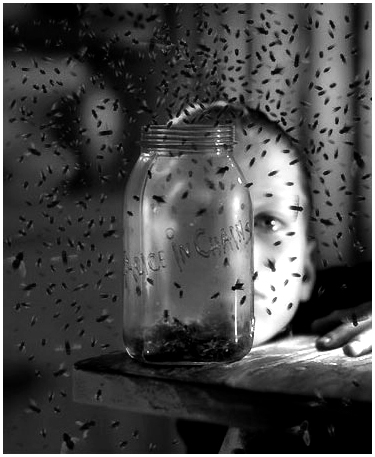
Edited version of “Jar of Flies” EP cover
(Public Domain)
After the recording of Dirt, the band would go on tour with Ozzy Osbourne for the No More Tours tour, after which they would then play the music festival Lollapalooza with various other alt-rock bands such as Tool, Rage Against the Machine, and Primus. While the band was touring, bassist Mike Starr was fired for his drug use, eventually being replaced by Ozzy Osbourne bassist Mike Inez. However, even after such a prolific tour, the band would return home to find out they had been evicted from their residence after failing to pay their rent on time. The band moved into London Bridge Studios in Seattle, where they would create and record a new EP in just one week. This EP would be titled Jar of Flies, and would feature a major change in sound from the band’s main albums. Rather than the aggressive, metal-inspired grunge music they made on their studio albums, the recording for Jar of Flies, as well as other EPs by the band, utilized more acoustic instrumentation, creating a more soothing and relaxing experience, if no less dreary in tone than their other work. The album tackles themes such as isolation and depression in a rather uncompromising manner, yet the band allows themselves to sit with their own sadness and reflect on a much greater level than ever before . Despite the shift in sound and quick recording process, Jar of Flies also did well commercially, with “No Excuses” becoming the band’s first No. 1 song on the charts, “I Stay Away” being nominated for a Grammy in 1995, and “Nutshell” receiving multiple covers and becoming something of a fan-favorite. Surprisingly, this small EP the band recorded out of their own homes in a week, became one of their most acclaimed and most stand-out projects.
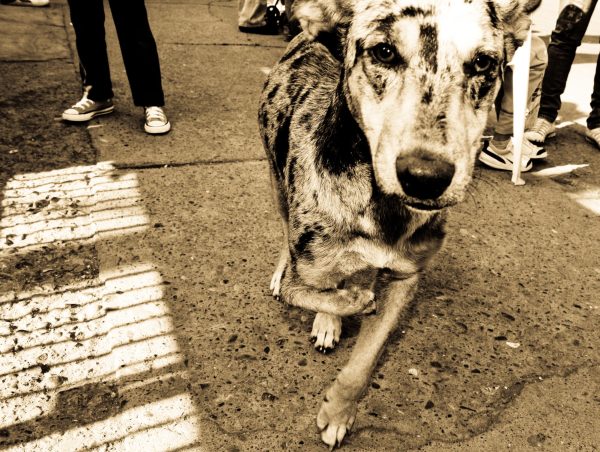
After the release of Jar of Flies, even as the band continued on their next album, the internal state of the band had become more fragile than ever. Staley’s heroin addiction had reached its worst point thus far, which affected his involvement with the next album, leaving Cantrell to sing lead vocals on three of the album’s songs even though Staley wrote most of the lyrics. Released in 1995, Alice in Chains, the band’s self titled album, similarly to Vitalogy within Pearl Jam’s discography, is more diverse stylistically, with both slower, more acoustic cuts and harder, harsher tracks. The self-titled album is less heavy and “in-your-face” than Dirt, with more of a relaxed and reflective yet pained atmosphere, no doubt influenced by the band’s work on Jar of Flies. Though both albums could hit hard emotionally, the self-titled simply does so with less intensity, though with no less potency. The fact that Alice in Chains itself, considering the state of the band, had even released is often seen as impressive, and so to have another solid addition to their discography come from this period is even more of a shock. With this, the self-titled album furthered the band’s streak of commercial success, as the album debuted at No. 1 on the Billboard 200, with the single “Grind” becoming a hit on the Mainstream Rock Chart, and “Grind” and “Again” both being nominated for Grammies.
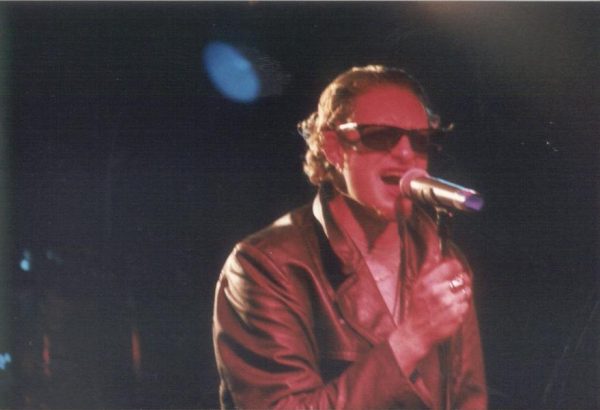
After Alice in Chains was released, the band remained inactive for a long period of time, which can be credited to Staley’s worsening addiction. In 1996, Alice in Chains played their own critically appraised set on MTV Unplugged, though sadly it would be the band’s last with Staley. As Staley’s condition worsened, he began to isolate himself from the other bandmates, and this combined with his already impaired ability to play a part in the band greatly stalled the band’s output. This carried on for years, until Staley eventually passed away in 2002 due to an overdose. The band would later re-form in the mid-2000s and begin putting out new music with a new backing vocalist, William DuVall, but the band, and grunge music as a whole, had been permanently changed and altered by the original run of Alice in Chains‘ ’90s output. Through their career with Staley, the band had both taken their own spin on grunge, one more theatrical and metal-influenced, and had subsequently put out some of the most harsh yet often reflective work of the time. The band had left a permanent mark on the ’90s movement which would truly not have been the same without them.
Soundgarden
Soundgarden began life in 1985 as a trio from Seattle made up of frontman Chris Cornell on both drums and vocals, guitarist Kim Thayil, and bassist Hiro Yamamoto. This was before drummer Scott Sundquist joined, which would allow Cornell to focus on vocals. The group took its name from an art piece in Seattle (The Sound Garden), and during the mid 1980s, the band began to make some underground buzz, making their first appearance on vinyl in 1986 and refocusing their efforts outside of their native region, causing Sundquist to leave the band and replacing him with Matt Cameron. Once the band focused on official recording, the band would release a couple of EPs on the Sub Pop label, but would release their first studio album, Ultramega OK, on independent label SST Records, though they would join major label A&M for Louder Than Love, their sophomore record, capitalizing on the momentum they were beginning to build up.

Ultramega OK and Louder Than Love were the band’s two releases during the 1980’s, and similarly to Nirvana’s debut, they show themselves as appealing in the sense of demonstrating the appeal of underground grunge at the time. Though the band’s first two albums do not immediately make the band stand out as much as bands such as Pearl Jam or Alice in Chains did on their debuts, hints of their potential are still present, most notably Chris Cornell’s impassioned vocals, which hit incredibly high notes and remain intense throughout both albums. His vocals show influence from hard rock vocalists such as Led Zeppelin’s Robert Plant or Black Sabbath’s Ozzy Osbourne with the way he fully immerses himself into the dramatic atmosphere of each song. There is also a certain level of controlled chaos to both albums that the band executes very well, as despite the more dry production and often unpredictable guitar solos and drumming, the band still works well together as a unit, showcasing both the immense vocal talent present in Cornell as well as their strengths when collaborating. The band’s influences from classic and hard rock in general shine through as well, especially in Cornell’s vocals, which give their earlier music more of an “old-school” feeling despite the new style they operated in.

(Public Domain)
Louder Than Love would be supported by various live-dates and even MTV radio play, and though Yamamoto, who had been making less and less contributions to the band’s music for different reasons, would leave the band not long after its release, the band was still becoming greater in popularity, if not yet fully into the mainstream. The band was left working through the hassle of finding another bassist, however, and they would decide on Ben Shepherd (with Jason Everman, a past guitarist for Nirvana, playing with the band before they changed their minds). Motivated by the now buzzing grunge scene that was gaining steam, the band released Badmotorfinger, their third album, in 1991. Badmotorfinger, though not a major switch up in style, shows the band working at the height of their talent so far. Combining their hard rock inspirations with punk, thrash metal, and, obviously, grunge sensibilities, the band members come further into their own with this album. Cornell’s vocal performances are even more expressive and dynamic than before, and the band’s complex rhythms and focused riffs further add to the impact of these songs. Though the band’s playing is relatively reined in at certain points, at others they still demonstrate the controlled chaos they had developed in their earlier releases with often disorganized guitar solos and quick drum changes. This was even despite the higher status the band had achieved, and would achieve, with this record. Badmotorfinger, which also released right around the explosion of grunge, would be the band’s most successful album at that point, bringing now iconic grunge singles such as “Rusty Cage,” “Outshined,” and “Jesus Christ Pose,” which would gain substantial airplay and further contribute to Soundgarden’s growing success. The band would play alongside Metallica, they would go on a full tour opening for Guns n’ Roses in 1992, and they would even tour at Lollapalooza II with the Red Hot Chili Peppers and Pearl Jam.

(Public Domain)
Superunknown, Soundgarden’s fourth album, would show the band moving into an even darker direction and taking on more influence from metal and psychedelic rock, to form one of their most unique albums. The blend of influences the band brings on Superunkown and their improved ability to demonstrate introspection on songs such as “Fell On Black Days” and the hit “Black Hole Sun” give them a sound that is more detailed while still retaining the manic energy they displayed in their earlier days on tracks such as “Let Me Drown” and “Spoonman.” The cohesive nature of the project, combined with this unique sound, makes Superunknown feel that much more ominous and dystopian, maintaining a dreary and hopeless tone throughout. Even so, the album would become one of their best known LPs. Superunkown would be the band’s commercial breakthrough, landing at No. 1 on the Billboard 200 and with “Black Hole Sun” becoming the band’s best known song. Many songs from the album, especially “Fell on Black Days” and “Spoonman,” would become some of the band’s most popular songs as well. Superunknown, even with how different the album could be from their past releases, would become the most popular album the band made.
Down on the Upside, Soundgarden’s fifth album, would be the record that followed up their most popular yet, though unlike what they did with Superunknown, the band takes a more relaxed and clean approach with Down on the Upside. In comparison with the often messy performances on their earlier releases, the band appears much more controlled and on this album, with even Cornell’s typically wild vocals appearing much more reined in. The relentlessly dark atmosphere of Superunknown is dialed back, even if the lyrics maintain a grim tone, and the borderline hard rock and post-grunge sound of the record separates it from the others in their catalog in an interesting way. Down on the Upside, though not as successful as Superunkown, still was a commercial success, debuting at No. 2 on the Billboard 200, with hit singles such as “Pretty Noose” and “Burden On My Hand” still demonstrating the band’s relevancy. However, this would become the band’s last album for quite a while.

Like many grunge bands of the time, the success of the band began to cause problems, and on the band’s tour for Down on the Upside, the internal issues the band had been dealing with finally came to a head. Long into their Honolulu show, as Shepherd slammed his bass down on the stage and stormed off, with the other members following suit, the stress the band had been under became glaringly obvious. Coupled with the exhaustion and burnout from touring and working in support of their band, its members had begun to feel the strain of their lifestyle, and so two months after the tour, the band would declare their break up. However, it appeared that the band felt the need to return, and Soundgarden would begin to perform reunion shows in 2010, along with a full tour in 2011. In the midst of this resurgence in activity, Soundgarden announced they were working on a new album. King Animal would be released in 2012, and the band would continue touring, even co-headlining a tour with Nine Inch Nails in the U.S. Though the band would begin to work on another project, the band’s trajectory was halted when, in 2017, frontman Chris Cornell took his own life. This event would shake Soundgarden and eventually lead to its end, as Soundgarden’s remaining members decided they could not continue without Cornell. However, the band’s legacy would continue on, as the band played a tribute concert for Cornell in 2019. Soundgarden’s importance to grunge music, bringing energetic vocals and performances, psychedelic rock and heavy metal influences, and a great tenacity to the movement that was theirs and uniquely theirs would be felt forever. The music world would be permanently impacted by Soundgarden’s success and musical accomplishments.
Others

Though the Big Four are often considered the most influential within grunge, it would not do the scene justice to mention many other important figures of the time whom either played as grunge or were influenced by the sounds of grunge. Seattle glam rock-inspired band Mother Love Bone would be one of the earliest grunge-influenced bands to gain popularity, rising up to a promising start in Seattle before the untimely passing of frontman Andrew Wood. Still, two of their members would go on to form Pearl Jam, and so both their contributions to grunge and further extending influence can still be felt. Formed in Chicago, Illinois, The Smashing Pumpkins would integrate grunge into their own sounds, experimenting with genres such as shoegaze, art rock, and psychedelic rock in the process. Though their lineup has changed repeatedly, the band is still active, having released an album this year and opened up for Green Day on their Saviors Tour. Alternative rock and grunge band Hole, led by Courtney Love (later Kurt Cobain’s wife) began to gain popularity around the early 1990s, being influenced by LA’s punk rock scene. Though the band would later break up, reform, and then have their name retired, they are known for being one of the most successful female-fronted rock bands of all time. Originating from San Diego, California, Stone Temple Pilots would release several commercially successful albums, initially taking inspiration from the sounds of grunge before diving further into other influences such as classic and psychedelic rock.
The inspirations brought by the movement of grunge extend beyond simply the Big Four themselves, and can be found even within today’s music, as many of these bands are still together and touring, and many bands even took their own liberties in using the sounds of grunge to inspire, enhance, and expand their own sounds while playing with other rock subgenres. Without grunge, we would not have many of the most iconic and influential rock bands in history, and so through both the Big Four and various other rock outfits, grunge remains cemented in rock and music canon forever.











